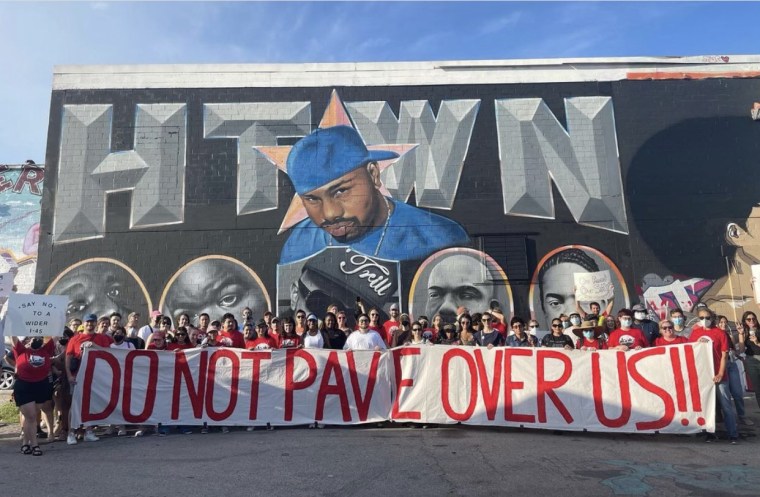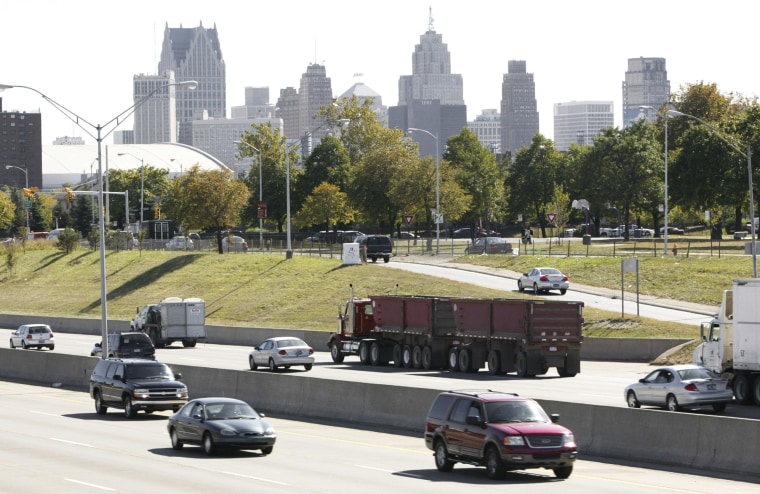Nearly 60 years after a mile-long interstate uprooted a pair of bustling Black neighborhoods in Detroit, leaders plan to turn part of the highway into a lower-speed boulevard in a $300 million project that will reconnect those neighborhoods and cut down on highway pollution. Last month, the Biden administration awarded Michigan $104.6 million in grant funding from the 2021 bipartisan infrastructure law to help with the project.
Black Bottom was a predominantly Black neighborhood in the city and the adjacent Paradise Valley served as the town’s entertainment and business district, boasting jazz clubs and several other Black-owned businesses. The area was razed and some 100,000 Black residents were displaced when the city built Interstate 375 in 1964 as part of the country’s interstate highway program, which established more than 40,000 miles of interstates across the United States — demolishing homes, crippling communities and perpetuating inequality in the process.
“It’s a physical barrier that divides up a community or separates one community from another,” said Antoine Bryant, Detroit’s director of planning and development. “It’s a key initiative where we’re looking to ensure that we’re righting a policy wrong from, essentially, 60 years ago. It led to the demise of not only the center for African American culture, housing and promotional activity, but also the elimination of generational wealth for many African Americans in the city.”
The project, set to break ground in 2024, will fill the trench that carries the highway and add amenities like bike lanes, wider sidewalks and pedestrian crossings, Bryant said. Transportation Secretary Pete Buttigieg acknowledged the harmful impacts of the 1956 highway program when launching the grant initiative over the summer, saying, “we can’t ignore the basic truth that some of the planners and politicians behind those projects built them directly through the heart of vibrant, populated communities -- sometimes in an effort to reinforce segregation. Sometimes because the people there had less power to resist. And sometimes as part of a direct effort to replace or eliminate Black neighborhoods.”
The stories of Paradise Valley and Black Bottom are familiar in cities across the country. From 1957 to 1977, the Federal-Aid Highway Act of 1956 displaced over 475,000 households and 1 million people, according to the U.S. Department of Transportation. Decades later, state and city leaders across the country are contending with the now-aging roadways, and many residents are urging them to confront past decisions to build highways that have negatively affected Black and Latino communities. But what some may consider a past to be reckoned with is an ongoing injustice, say advocates across the country fighting to keep highways from being built or expanded through Black and Latino neighborhoods.
In Houston, organizers with Stop TxDOT I-45 are pleading with the state to cancel plans to widen Interstate 45 from downtown Houston north to the Sam Houston Tollway, adding lanes in each direction, according to the Houston Chronicle. Widening the interstate would come with myriad concerns both environmental — air pollution and flooding — and social. The plan would uproot at least 300 businesses that employ more than 24,000 people and destroy 1,400 homes, according to NBC affiliate KXAS. Organizers with Stop TxDOT I-45 said expanding in the area would hurt the predominantly Black and Latino communities along the stretch.
Kendra London joined Stop TxDOT I-45 three years ago when she learned of the state’s plans to expand the highway. She said her family, longtime Fifth Ward residents, was displaced in the 1970s during Interstate 10 construction. So she’s aware of the harmful impacts of highway projects. She grew up hearing stories about her grandmother arriving home from work to learn she’d no longer have a backyard due to highway expansion.
“They displaced residents in ʼ73; they’re going to displace residents here again in 2022,” London, 41, said of the Texas Department of Transportation. She highlighted a pair of public housing communities scheduled to be removed for the freeway widening. “It will destroy Clayton Homes, they’re going to destroy the backside of Kelly Village. The residents don’t know where they’re going to go.”

Officials with the Texas Department of Transportation did not immediately respond to a request for comment. But a TxDOT spokeswoman, Veronica Beyer, told the Houston Chronicle that the expansion is necessary. “As more people move to Texas, the reality is that our roads will become more congested. Without additional capacity, increased traffic will spill further into neighborhoods and local streets,” Beyer said.
Some 350 miles away, residents of Allendale, Louisiana, are working to stop the I-49 Inner City Connector Project, which would extend a 3.6-mile stretch of I-49 through the small, predominantly Black neighborhood in Shreveport. Dorothy Wiley, part of the Allendale Strong advocacy group, said she’s lived in Allendale for more than 15 years after fleeing New Orleans following Hurricane Katrina.
“It would destroy the park and run over a bayou,” Wiley said of the connector. “It would take out all the homes here and some businesses, churches. And living within 500 feet of a freeway causes asthma, heart issues, preterm labor. Let’s invest in the neighborhoods that have been threatened by these freeways. We can heal more communities.”
The proposed plan would connect I-49 at the I-20 interchange in Shreveport to I-49 North, according to a website for the project. State leaders have been working on the plan since at least 2009. But Wiley said Allendale Strong has been excluded from conversations about the plan. “Allendale Strong does not have equity of voice in the process. We are treated as though we do not count. They ignore our informed input,” she said.
However, some welcome the connector. Bruce Roberts, director of the North Shreveport Business Association, told KTSB that the connector would provide better access to Allendale and encourage economic development. “You’ll see developments pick up there, you’ll see businesses pick up there because they have a broader area. I think that we have to see what the broader picture is here,” he said.
Neither the Northwest Louisiana Council of Governments nor the Louisiana Department of Transportation and Development immediately responded to a request for comment.
Stop TxDOT I-45 and Allendale Strong are two of more than 70 groups across the country that comprise the Freeway Fighters Network, a coalition of groups advocating for the dismantling of harmful highways and urging city leaders not to expand highways or build new ones. Ben Crowther, who coordinates the network, said that along with the Detroit plan, Interstate 81 in Syracuse, New York, and the McGrath Highway in Sommerville, Massachusetts, are other highway-to-boulevard projects that are close to breaking ground. Such projects seek to address pollution and social damage by transforming aging highways into lower-speed streets. From Maine to California, groups are fighting their own battles against city and state leaders over these highways, which, Crowther says, is proof that highways gutting and polluting Black and Latino neighborhoods aren’t simply a thing of the past.
“At the time we’re trying to repair damage that we’ve caused, we also need to stop causing new damage,” Crowther said, explaining how the network came to be. “We hadn’t actually stopped building new highways that still harm communities, predominantly communities of color. We wanted to bring all these local coalitions together to create a national movement, a unified voice to push the public and the federal government to rectify some of the damages the highway system has caused and stop causing new damage.”
Crowther said the grants and support through Biden’s infrastructure plan are a great step in the right direction, but is urging leaders to think beyond simply removing highways. Lauren Hood, chair of Detroit’s planning commission, said the city must consider how it will restore the community even after Interstate 375 is gone. Hood said it’s unlikely that officials even considered the demolished town in their plans to remove the interstate before residents brought the history to their attention. Hood recalled attending a public meeting of the Michigan Department of Transportation in 2021, in which officials spoke of the walkability of a new boulevard but “didn’t mention Black Bottom one time.”
She said that “negative feedback” from the attendees, frustrated that officials had not initially acknowledged Black Bottom, is what most likely prompted city and state leaders to include the destroyed Black neighborhood in the I-375 plan.
“We should be thinking about long-term repair,” Hood said, highlighting the Black communities affected by the highway. “We are owed something, something that exists in perpetuity. Not just a one-time offering. It shouldn’t just be paid compensation; we also need power. We also need to be in positions to hold agencies accountable so something like this doesn’t happen again.”

